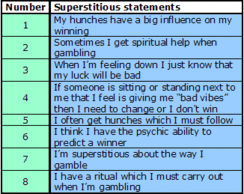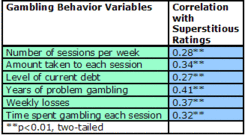Superstitions are so common that even the most diehard realists sometimes fall prey to believing them. It is well known that famous athletes have their beliefs: Michael Jordan led the Chicago Bulls to six NBA Championships wearing his “lucky” college gym shorts underneath his uniform. Golfer Tiger Woods supposedly believes that the color red is lucky for him (Superstitions run rampant, 2004). Gambling, in particular, has long been associated with all kinds of superstitions, for example: (1) A throw of two ones in dice is called Snake Eyes, a reference to the devil who presented himself to Eve in that form; (2) always blow on your cards or dice for luck; (3) never keep dogs near a gambling table; and (4) keep a horny toad toenail for luck (Dossey, 1992). But how does being superstitious affect individuals’ tendencies toward problem gambling? A new study from Joukhador, Blaszczynzki, & Maccallum (2004) provides evidence of a link between superstitious beliefs and gambling problems.
Joukhador et al. recruited 56 (20 female) problem Electronic Gaming Machine (EGM) gamblers from both a university-affiliated treatment clinic and a community gambling counseling agency. A control group of 74 non-problem gamblers were recruited from colleagues and acquaintances of the study researchers. The researchers required participants of the problem gambling subject pool to have a South Oaks Gambling (SOGS) score of at least 10 (mean SOGS score = 12.9). In addition to the SOGS, all subjects completed a brief interview to obtain demographic information and gather other dependent measures: number of gambling sessions per week, amount brought to each gambling session, level of debt, years of problems with gambling, money lost each week, time spent at each gambling session, and an eight-item superstition test, which is shown in Table 1. Subjects rated, on a five-point scale ranging from zero (not at all) to four (very much), the strength of their beliefs in the eight listed items.
Table 1. Eight-item superstition test (Joukhador et al., 2004)
Significant differences were found between problem and non-problem gamblers on several demographic variables as well as in the endorsement of superstitious beliefs. Problem gamblers reported significantly greater (1) number of gambling sessions per week, (2) amount of money taken to gambling sessions, (3) current debt, (4) years of problem gambling, (5) weekly losses, and (6) time spent at gambling sessions. Mann-Whitney U-tests revealed that problem EGM gamblers endorsed significantly more superstitious beliefs (M = 9.6, SD = 6.7) as compared to non-problem gamblers (M = 2.2, SD = 3.4;), respectively (Z= -5.8, p < 0.05). No significant differences in superstitious beliefs were found between males and females. Table 2 shows how superstitious beliefs correlated with each gambling behavior variable. As Table 2 demonstrates, people who endorsed superstitious beliefs spent more time and more money gambling than those who did not endorse as many superstitious beliefs.
Table 2. Correlations (Kendal tau-b method) between gambling behavior variables and superstition ratings
A limitation of this study is that the researchers did not define “superstition” for the interviewed subjects. Perceptions of a concept such as “superstition” might differ greatly from subject to subject. It is not clear that these eight items measure one underlying construct “superstition.” Another limitation involves the choice of subjects. Problem gamblers recruited from clinics and counseling agencies are generally treatment seekers and might not be representative of average problem gamblers. Likewise, the controls in this study, colleagues and friends of the researchers, might not be representative of average non-problem gamblers. These subjects may have greater knowledge of the study’s methods than the average non-affiliated person.
Overall, this study provides evidence that problem gamblers more consistently endorse superstitious beliefs than a group of non-problem gamblers. WAGER 8(43) suggested a connection between heightened superstitious beliefs and gambling-related problems. This study seems to confirm this hypothesis and provokes questions about how superstitious beliefs and gambling-related problems are connected. Perhaps superstitious beliefs precede excessive gambling or perhaps excessive gambling precedes superstitious beliefs. Future prospective studies are needed to shed light on this issue.
Comments on this article can be addressed to Mike Stanton.
References
Dossey, D. E. (1992). The Tradition of Superstitions. Retrieved 4/5/04, 2004, from
http://www.brownielocks.com/superstitions.html
Joukhador, J., Blaszczynski, A., & Maccallum, F. (2004). Superstitious beliefs in gambling among problem and non-problem gamblers: preliminary data. Journal of Gambling Studies, 20(2), 171-180.
Superstitions run rampant. (2004, 4/5/04). Retrieved 4/5/04, from http://www.newsstar.com/stories/103101/new_super.shtml






